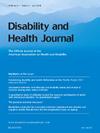Associations between disability status and stressors experienced due to the COVID-19 pandemic among women with a recent live birth, 2020
IF 3.3
2区 医学
Q1 HEALTH CARE SCIENCES & SERVICES
引用次数: 0
Abstract
Background
Women with disability face more stressors around the time of pregnancy than women without disability. Limited research exists on stressors experienced due to the COVID-19 pandemic among pregnant and postpartum women with and without disability.
Objective
Examine the association between disability status and experiencing certain COVID-19 stressors among women with a recent live birth.
Methods
We analyzed Pregnancy Risk Assessment Monitoring System data from 14 jurisdictions implementing the Disability and Maternal COVID-19 Experiences supplement surveys among women with a live birth from June–December 2020. We examined the prevalence of 12 individual stressors and seven stressor types (any stressor, economic, housing, childcare, food insecurity, mental health, and partner-related), by disability status. For each stressor type, we calculated adjusted prevalence ratios (aPRs) using logistic regression to determine if women with disability were more likely to experience particular stressor types, controlling for respondent age, education, race and ethnicity, marital status, and payment at delivery.
Results
Among 5961 respondents, 6.3 % reported a disability. Compared with women without disability, those with disability were more likely to experience any stressor (aPR 1.19, 95 % CI 1.14–1.24), including economic (aPR 1.38, 95 % CI 1.23–1.56), housing (aPR 1.56, 95 % CI 1.09–2.24), childcare (aPR 1.32, 95 % CI 1.11–1.58), food insecurity (aPR 2.18, 95 % CI 1.72–2.78), mental health (aPR 1.49, 95 % CI 1.37–1.62), and partner-related stressors (aPR 2.00, 95 % CI 1.55–2.58).
Conclusions
Findings highlight the challenges experienced by pregnant and postpartum women with disability during public health emergencies and considerations for this population in preparedness planning.
2020年,近期活产妇女因COVID-19大流行而经历的残疾状况与压力因素之间的关系。
背景:残疾妇女在怀孕期间面临的压力源比正常妇女多。关于有残疾和没有残疾的孕妇和产后妇女因COVID-19大流行而经历的压力源的研究有限。目的:探讨近期活产妇女残疾状况与经历某些COVID-19应激源之间的关系。方法:我们分析了14个司法管辖区在2020年6月至12月期间对活产妇女实施的残疾和孕产妇COVID-19经验补充调查的妊娠风险评估监测系统数据。我们根据残疾状况检查了12种个体压力源和7种压力源类型(任何压力源,经济压力源,住房压力源,儿童保育压力源,食品不安全压力源,心理健康压力源和伴侣相关压力源)的患病率。对于每种压力源类型,我们使用逻辑回归计算调整患病率(aPRs),以确定残疾妇女是否更有可能经历特定的压力源类型,控制受访者的年龄、教育程度、种族和民族、婚姻状况和分娩时的付款。结果:在5961名受访者中,6.3%的人报告有残疾。与无残疾妇女相比,残疾妇女更有可能经历任何压力源(aPR 1.19, 95% CI 1.14-1.24),包括经济(aPR 1.38, 95% CI 1.23-1.56)、住房(aPR 1.56, 95% CI 1.09-2.24)、儿童保育(aPR 1.32, 95% CI 1.11-1.58)、食品不安全(aPR 2.18, 95% CI 1.72-2.78)、心理健康(aPR 1.49, 95% CI 1.37-1.62)和伴侣相关压力源(aPR 2.00, 95% CI 1.55-2.58)。结论:研究结果强调了残疾孕妇和产后妇女在突发公共卫生事件中所面临的挑战,以及这一人群在应急计划中的考虑因素。
本文章由计算机程序翻译,如有差异,请以英文原文为准。
求助全文
约1分钟内获得全文
求助全文
来源期刊

Disability and Health Journal
HEALTH CARE SCIENCES & SERVICES-PUBLIC, ENVIRONMENTAL & OCCUPATIONAL HEALTH
CiteScore
7.50
自引率
6.70%
发文量
134
审稿时长
34 days
期刊介绍:
Disability and Health Journal is a scientific, scholarly, and multidisciplinary journal for reporting original contributions that advance knowledge in disability and health. Topics may be related to global health, quality of life, and specific health conditions as they relate to disability. Such contributions include:
• Reports of empirical research on the characteristics of persons with disabilities, environment, health outcomes, and determinants of health
• Reports of empirical research on the Systematic or other evidence-based reviews and tightly conceived theoretical interpretations of research literature
• Reports of empirical research on the Evaluative research on new interventions, technologies, and programs
• Reports of empirical research on the Reports on issues or policies affecting the health and/or quality of life for persons with disabilities, using a scientific base.
 求助内容:
求助内容: 应助结果提醒方式:
应助结果提醒方式:


